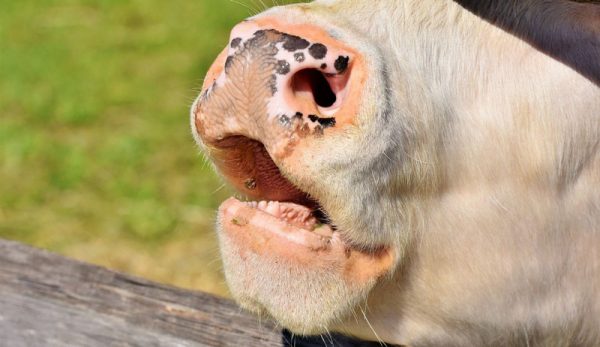
This month we conclude our two-part series on livestock teeth. Last month we started with the normal findings in your farm animals’ mouths. This month, let’s take a look at some common abnormal dental issues in ruminants and horses.
The Horse’s Mouth
We mentioned last time that horses’ teeth continuously grow—or, more accurately, emerge from below the gums—over the course of their lives. This constant tooth growth can create instances of uneven wear. In turn, sharp points can develop in the horse’s mouth, leading to cheek or tongue ulcerations.
If you’ve ever had a cold sore on your lip, you have some understanding of this discomfort. And you can likely see how this would lead to the dropping of food from the mouth (called quidding) and weight loss.
Uneven tooth wear can also result in the development of an irregular molar grinding surface. Sometimes one side of the mouth may slope downwards (called ramp mouth) or resemble small hills, called wave mouth. Both of these conditions lead to inefficient grinding. Again, this can lead to quidding, weight loss and sometimes even chronic pain in the jaw joint itself.
For these reasons, livestock (and especially horses) should have their teeth checked by a veterinarian at least once a year. Usually, a horse requires some filing down of sharp edges that have developed.
This is called floating. A veterinarian will use a long, hand-held rasp (called a float) to wear down sharp edges. With the horse under light sedation, the procedure doesn’t cause any pain.
Read more: Check out the first part in this series for more livestock teeth and mouth issues to watch out for.
Cattle Issues
Other livestock, notably cattle, don’t typically have the uneven wear issues with their teeth like horses do. Why? Most cattle housing allows them to maintain a diet of constant grazing. (Many horses are not allowed to graze as often as they should.)
Instead, cattle suffer from various bacterial mouth issues. These stem mostly from the fact that around the barn and in large feeding bunks lie sharp, pointy objects. Undiscerning cattle can slurp those objects up with the rest of the hay or grain.
Lumpy jaw is the common name for a specific bacterial infection from the Actinomyces genus. It typically occurs in cattle and hogs and creates large, firm masses in the mandible. These bacteria commonly live in the mouth.
They will also, however, opportunistically infect bone if the inside of the mouth is damaged from the animal eating coarse and pokey hay or other roughage.
Infection takes the form of chronic and slow growing masses on the jaw—hence this disease’s name. The bone masses may become large enough to interfere with eating or even breathing, depending on their location.
The treatment of choice in cattle for lumpy jaw is multiple IV injections of sodium iodide. Unfortunately, this infection in swine is not as responsive to this therapy. Avoid feeding your livestock overly coarse or stemmy feedstuffs to prevent this condition.
Read more: Also keep an eye out for pinkeye in your cattle. Here’s how!
Wooden Tongue
Wooden tongue is another bacterial infection seen in the mouths of livestock. As the name suggests, infection results in a swollen, infected tongue that becomes firm and difficult to move.
Caused by the bacteria Actinobacillus lignieresii, this infection mostly occurs in cattle. It can also occur in sheep, horses, pigs and dogs.
The bacteria normally inhabits the upper gastrointestinal tract. But it can invade the mouth via oral abrasions, again mostly through eating rough forage. It can (though rarely does) also travel through the lymphatic system and infect other organs.
A vet will treat this similarly to lumpy jaw: multiple administrations of sodium iodide. In both diseases, a vet will also give secondary antibiotics.




